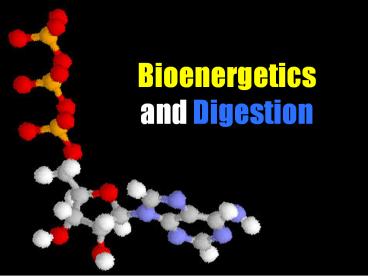Bioenergetics and Digestion - PowerPoint PPT Presentation
Title:
Bioenergetics and Digestion
Description:
Bioenergetics and Digestion We ll be discussing Trends and Various Strategies Used by Organisms to Process Food Process of Digestion in Man Disorders of the Human ... – PowerPoint PPT presentation
Number of Views:358
Avg rating:3.0/5.0
Title: Bioenergetics and Digestion
1
Bioenergetics and Digestion
2
Well be discussing
- Trends and Various Strategies Used by Organisms
to Process Food - Process of Digestion in Man
- Disorders of the Human Digestive System
3
Core Concepts
- Nutritional requirements
- Animals are heterotrophs that require food for
fuel, carbon skeletons, and essential nutrients. - Metabolic rate provides clues to an animals
bioenergetic strategy. - Evolutionary adaptations of feeding mechanisms
and digestive systems - Diverse feeding adaptations have evolved among
animals. - Structural adaptations of digestive systems are
often associated with diet. - Symbiotic microorganisms help nourish many
vertebrates. - Overview of food processing
- The four main stages of food processing are
ingestion, digestion, absorption, and
elimination. - Digestion occurs in specialized compartments.
- The oral cavity, pharynx, and esophagus initiate
food processing. - The stomach stores food and performs preliminary
digestion. - The small intestine is the major organ of
digestion and absorption. - Reclaiming water is a major function of the large
intestine. - Hormones regulate digestion.
- Reclaiming water is a major function of the large
intestine. - Nutrition and disorders of the human digestive
system - A healthful diet provides both fuel and building
materials. - Nutritional disorders damage health.
4
Keywords
- minerals
- nutrition
- obesity
- pancreas
- peristalsis
- peptic ulcers
- peristalsis
- phagocytosis
- pharynx
- salivary glands
- small intestine
- sphincters
- stomach
- undernutrition
- vesicles
- villus
- vitamins
- absorption
- alimentary canal
- amebocytes
- anorexia
- bile
- bolus
- brush border
- bulimia
- cecum
- chyme
- complete digestive tract
- crop
- digestion
- duodenum
- elimination
- endocytosis
- enzyme
- esophagus
- essential nutrient
- extracellular digestion
- filter feeders
- gallbladder
- gastrovascular cavity
- gizzard
- heterotroph
- ileum
- incomplete digestive tract
- ingestion
- intracellular digestion
- jejunum
- large intestine
- liver
- malnutrition
- microvilli
5
(No Transcript)
6
Bioenergetics of an animal
- Food
- Fuel
- C-skeletons
- essential nutrients
- ATP powers resting metabolism, activity, and
temperature regulation - Excess calories can be used for biosynthesis
- 85-90 of energy from food is lost as heat
7
Metabolic rates
- Metabolism
- Anabolism
- Catabolism
- Resting/ Basal Metabolic Rate (BMR)
- energy/unit mass/hr
- Size and relative metabolic rate are inversely
proportional
8
Do plants have digestive systems?
- Carnivorous plants in marshlands have primitive
digestive systems - Habitats with N-poor soils
- Adaptation occasionally feed on animals
- CH2O ? Photosynthesis
- N minerals ? insects, etc.
9
Evolution of digestion
- Different types depending on diet and lifestyle
- All must accomplish
- Ingestion
- Digestion
- Mechanical breakdown
- Chemical breakdown
- Absorption
- Elimination
- Digestion occurs in specialized compartments
10
Intracellular digestion ( 1 ) (evolved in
single-celled protists, retained in simplest
animals)
- Protists
- Paramecium
11
Intracellular digestion ( 2 ) (evolved in
single-celled protists, retained in simplest
animals)
- SPONGES
12
Extracellular digestion ( by fungi )
- Fungi
- Sedentary heterotrophs living in or on food
supply - Saprotroph/parasites
- No internal cavity ? release digestive enzymes
Image from http//www.aber.ac.uk/fungi/graffeg/dec
omp/digestion-by-hypha.jpg
13
Extracellular and intracellular digestion1. In
animals with incomplete digestive systems (1)
- Cnidarians
- Hydra
14
Extracellular and intracellular digestion 1. In
animals with incomplete digestive systems (2)
- Platyhelminthes
- Planaria and tapeworms
15
Extracellular digestion 2. In animals with
complete digestive systems
- Nematoda to Vertebrates
- Earthworms
- 20 cm long with 100 segments
- 1st mouth
- Last anus
- Eats its way through soil
16
Feeding adaptations for ingestion
17
Comparison of vertebrate digestive systems
18
Mammalian digestion General plan
Organs of the GI tract
Accessory digestive organs
19
Comparison of mammalian digestive systems(Diet
plays an important role in the length and
structure)
20
(No Transcript)































